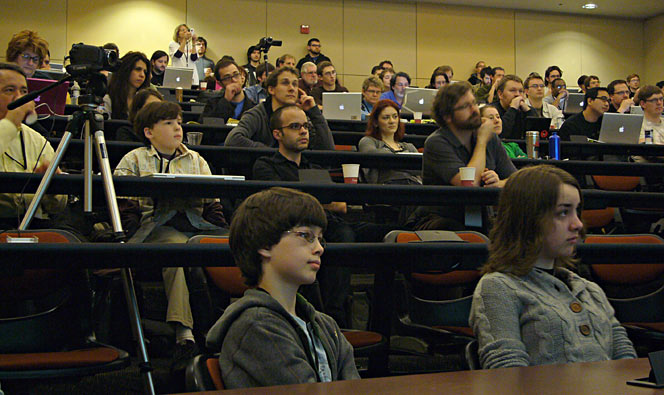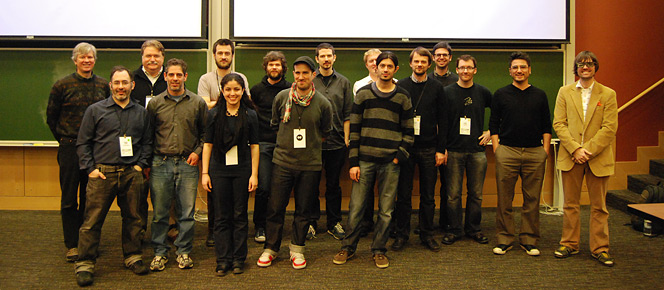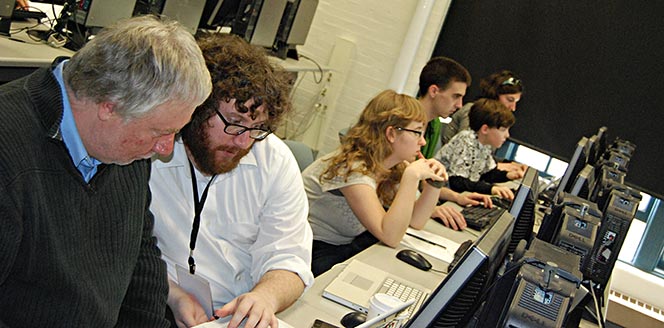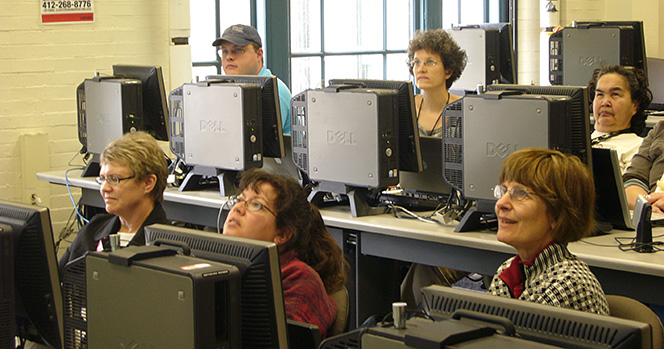Printed from www.flong.com
Contents © 2020 Golan Levin and Collaborators
Golan Levin and Collaborators
Projects
Sort by : Author | Date | Name | Type
- Installations
- Ghost Pole Propagator II
- Augmented Hand Series
- Eyeshine
- Re:FACE, Anchorage Version
- Merce's Isosurface
- Double-Taker (Snout)
- Opto-Isolator
- Eyecode
- Interstitial Fragment Processor
- Reface [Portrait Sequencer]
- Ghost Pole Propagator
- Footfalls
- Scrapple (Installation)
- The Manual Input Workstation
- Interactive Bar Tables
- Messa di Voce (Installation)
- Hidden Worlds of Noise and Voice
- Re:MARK
- Introspection Machine
- Audiovisual Environment Suite
- Dakadaka
- Rouen Revisited
- Performances
- Ursonography
- Scrapple (Performance)
- The Manual Input Sessions
- Messa di Voce (Performance)
- Dialtones (A Telesymphony)
- Scribble
- Net.Artworks
- Terrapattern
- Moon Drawings
- Free Universal Construction Kit
- QR Codes for Digital Nomads
- The Dumpster
- Axis
- JJ (Empathic Network Visualization)
- The Secret Lives of Numbers
- Alphabet Synthesis Machine
- Obzok
- Sketches
- Stria
- Dendron
- Slamps
- Banded Clock
- Floccus
- Stripe
- Meshy
- Directrix
- Yellowtail
- Streamer
- Blebs
- Self-Adherence (for Written Images)
- Poster design for Maeda lecture
- The Role of Relative Velocity
- Segmentation and Symptom
- Floccular Portraits
- Curatorial
- Mobile Art && Code
- ART AND CODE
- Code, Form, Space
- IEEE InfoVis 2008 Art Exhibition
- Solo exhibition at bitforms gallery
- IEEE InfoVis 2007 Art Exhibition
- Signal Operators
- Commercial / Industrial
- Motion Traces [A1 Corridor]
- Civic Exchange Prototype
- Amore Pacific Display
- Interactive Logographs
- Interval Projects
- Media Streams Icons
- Miscellaneous
- NeoLucida
- Rectified Flowers
- GML Experiments
- New Year Cards
- Admitulator
- Glharf (or Glarf)
- Finger Spies
ART AND CODE
2009 | Golan Levin with the STUDIO for Creative Inquiry at Carnegie Mellon University
ART AND CODE (sometimes written ART && CODE) is a conference series concerned with "programming environments for artists, young people, and the rest of us". The first conference event took place during the weekend of March 7-9, 2009 on the campus of Carnegie Mellon University (CMU) in Pittsburgh. It featured 26 workshops in 11 different arts-programming languages, as well as lecture presentations by fifteen of the key innovators leading significant revolutions in software-arts education. The second conference in the series, Mobile Art && Code, was concerned with arts in the mobile realm and took place in November 2009.
The first ART AND CODE conference brought together a diverse group of 234 registered participants from 7 countries and 23 states of the USA. Their ages ranged from 11 to 75. There were middle-school teachers from a Native American reservation in Montana; university professors of Computer Science; cyberpunk European C++ hackers; graduate students in media arts and interaction design; and a bevy of high-school and undergraduate students from a large swath of the American Rust Belt. Complete information about the ART AND CODE conferences can be found at their official web site, http://artandcode.com.
ART AND CODE featured workshop and lecture presentations by the lead creators behind some of the most widely-adopted toolkits for arts programming, including Processing, openFrameworks, Max/MSP/Jitter, Pure Data, VVVV, Scratch, Hackety Hack, Alice, ActionScript, ExtendScript, and Silverlight. The ART AND CODE presenters included John Maloney (MIT/Scratch), Golan Levin (CMU/Flong), Tom McMail (Microsoft Research), Ira Greenberg (Miami U. Ohio), Hans-Christoph Steiner (NYU/Pure Data), Evelyn Eastmond (MIT/Scratch), Casey Reas (UCLA/Processing), Zachary Lieberman (Parsons/openFrameworks), Theodore Watson (openFrameworks), Ben Fry (Seed Visualization Lab/Processing), Arturo Castro (openFrameworks), Sebastian Oschatz (Meso/VVVV), Daniel Shiffman (NYU), Luke DuBois (NYU/Cycling74), Dr. Woohoo (ExtendScript), and Why the Lucky Stiff (Hackety Hack). Not pictured below, but also presenting at the conference were Don Slater (CMU/Alice) and Dr. Wanda Dann (CMU/Alice).
Downloadable documents
- The ART AND CODE conference program:
 [1.3 MB pdf]
[1.3 MB pdf] - Full report about the conference and its outcomes:
 [2.0 MB pdf]
[2.0 MB pdf] - Abridged (2-page) report about the conference:
 [4.0 MB pdf]
[4.0 MB pdf]
Statement
Just as true literacy in English means being able to write as well as read, true literacy in software demands not only knowing how to use commercial software tools, but how to create new software for oneself and for others. Today, everyday people are still woefully limited in their ability to create their own software. Many would like to create their own programs and interactive artworks, but fear that programming is "too hard." The problem, it turns out, may not be programming itself so much as the ways in which it is conventionally taught.
Recently, a number of projects dedicated to democratizing the education of computational thinking have coalesced. Emerging primarily from the arts sector, a set of new programming tools (and accompanying pedagogic techniques) have been developed by artists, and for artists, to help regular folks and other non-computer-scientists learn to make software. Using visual and musical expression as the "hook", thousands of people have not only learned to code using these new environments, but found new reasons to code in the first place. These toolkits – many of which are free, open-source initiatives – have made enormous inroads towards expanding the computational skills and interests of hundreds of thousands of creative people worldwide.
The ART AND CODE conference was created to support the needs and interests of: artists, designers and musicians who want to create interactive art, information visualization, or personal software tools; teens, undergraduates, and graduate students who wish to combine art, design, interaction, and computer science; middle-school and high-school teachers who want a more expressive way of teaching programming and computer arts; college educators and professional artists who want to learn the most cutting-edge tools for interaction design; computer-science education researchers interested in visually-oriented learning tools; and anyone who has been wanting to learn how to program their own software, but hasn't known where to start.
The Presenters
The presenters at the ART AND CODE conference are leading some of the most significant transformations in computer arts education today. These conference presenters are the educators, artists and developers who have created programming toolkits, such as Processing, openFrameworks, MAX/MSP/Jitter, Pd, Scratch, and others, which have been adopted by hundreds of thousands of users around the world. At the symposium, each guest made a 45-minute presentation about the unique affordances of (and motivations behind) the toolkit they had created. Videos of these presentations, prefaced by my own 11-minute introduction, appear below and on the Vimeo account of the STUDIO for Creative Inquiry.
Full conference presentation videos located at Vimeo:
- [video] Golan Levin, introducing the ART AND CODE conference
- [video] Don Slater, presenting Alice
- [video] John Maloney and Evelyn Eastmond, presenting Scratch
- [video] Why the Lucky Stiff, presenting Hackety Hack
- [video] Casey Reas and Ben Fry, presenting Processing
- [video] Hans-Christoph Steiner, presenting Pure Data
- [video] R. Luke DuBois, presenting Max/MSP/Jitter
- [video] Sebastian Oschatz, presenting VVVV
- [video] Dr. Woohoo, presenting ExtendScript
- [video] Zach Lieberman, Theo Watson, and Arturo Castro, presenting openFrameworks
- [video] Tom McMail, Keynote speaker from Microsoft Research
The Attendees
One of the most inspiring and unusual aspects of the conference was the diversity of its attendees, who came from all walks of life. There were 234 registered participants, hailing from 7 countries and 23 states of the USA. Their ages ranged from 11 to 75. Seventeen participants (7%) were under 18 years of age; 35% of participants were female. Some attendees came together, as families, siblings and parent/child pairs. There were middle-school educators from a Native American reservation in Montana; university professors of Computer Science; nomadic cyberpunk European C++ hackers; graduate students in media arts and interaction design; and a bevy of high-school and undergraduate students from a large swath of the American Rust Belt. (Above) A row of attendees in a Processing workshop taught by Casey Reas.
(Above) Attendees in a Scratch workshop taught by Evelyn Eastmond and John Maloney.
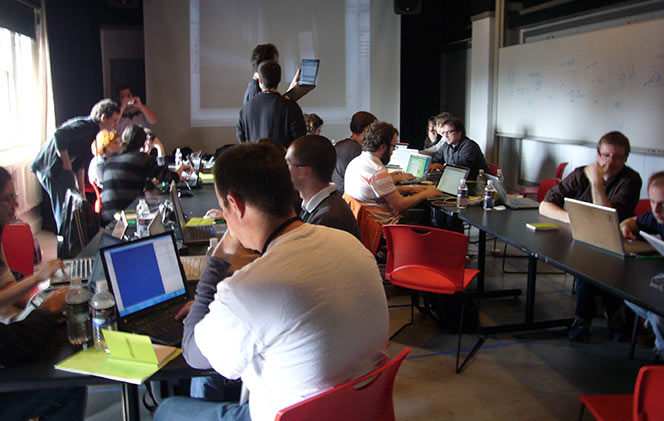
Above and below: a workshop in openFrameworks and C++ directed by Zachary Lieberman, Theodore Watson and Arturo Castro.
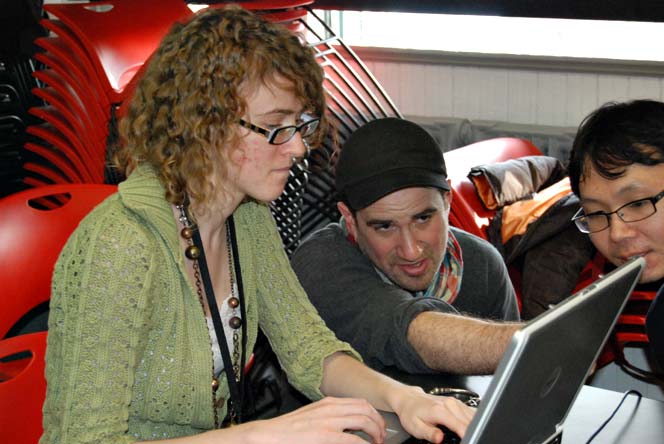
Acknowledgments
ART AND CODE was made possible by a generous grant from Microsoft Research, with oversight from the Center for Computational Thinking at Carnegie Mellon University, whose mission is to "advocate for the widespread use of computational thinking to improve people’s lives", and with administrative and logistical support from the STUDIO for Creative Inquiry at CMU, whose mission is to support "atypical, interdisciplinary, and inter-institutional research projects at the intersection of arts, sciences and technologies." ART AND CODE was directed by Golan Levin. Complete acknowledgments can be found on the official conference credits page.
Keywords
Arts programming, education, pedagogy, computational arts, computational design, programming toolkits, environments, development platforms, computer science, conference, symposium, workshops, Carnegie Mellon University, Center for Computational Thinking, STUDIO for Creative Inquiry, artandcode, #artandcode, Art and Code, Art & Code, Art && Code, Art&&Code, Art&Code.

